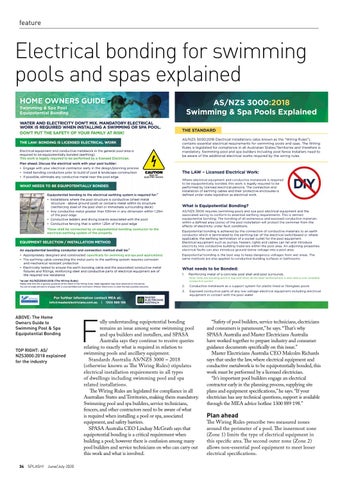feature
Electrical bonding for swimming pools and spas explained
ABOVE: The Home Owners Guide to Swimming Pool & Spa Equipotential Bonding TOP RIGHT: AS/ NZS3000:2018 explained for the industry
34 SPLASH! June/July 2020
F
ully understanding equipotential bonding remains an issue among some swimming pool and spa builders and installers, and SPASA Australia says they continue to receive queries relating to exactly what is required in relation to swimming pools and ancillary equipment. Standards Australia AS/NZS 3000 – 2018 (otherwise known as The Wiring Rules) stipulates electrical installation requirements in all types of dwellings including swimming pool and spa related installations. The Wiring Rules are legislated for compliance in all Australian States and Territories, making them mandatory. Swimming pool and spa builders, service technicians, fencers, and other contractors need to be aware of what is required when installing a pool or spa, associated equipment, and safety barriers. SPASA Australia CEO Lindsay McGrath says that equipotential bonding is a critical requirement when building a pool; however there is confusion among many pool builders and service technicians on who can carry out this work and what is involved.
“Safety of pool builders, service technicians, electricians and consumers is paramount,” he says. “That’s why SPASA Australia and Master Electricians Australia have worked together to prepare industry and consumer guidance documents specifically on this issue.” Master Electricians Australia CEO Malcolm Richards says that under the law, where electrical equipment and conductive metalwork is to be equipotentially bonded, this work must be performed by a licensed electrician. “It’s important pool builders engage an electrical contractor early in the planning process, supplying site plans and equipment specifications,” he says. “If your electrician has any technical questions, support is available through the MEA advice hotline 1300 889 198.”
Plan ahead
The Wiring Rules prescribe two measured zones around the perimeter of a pool. The innermost zone (Zone 1) limits the type of electrical equipment in this specific area. The second outer zone (Zone 2) allows non-essential pool equipment to meet lesser electrical specifications.
